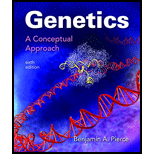
a.
To determine:
The probability that another child of the couple will have retinoblastoma.
Introduction:
Alfred Knudson in 1971, proposed a model to explain the genetic basis for cancer. He was studying retinoblastoma (develops in one eye but sometimes appears in both) and proposed that retinoblastoma results from separate genetic defects mainly two and both of which are required for the development of cancer. Mutations in the cells of a single eye results in “unilateral retinoblastoma” which is common and can occur to a normal person.
Mutations in the cells of both eyes result in “bilateral retinoblastoma” which is rare and cannot happen randomly like unilateral retinoblastoma. Individuals inherit the only single mutation from suffering relatives and if the second mutation occurs in any of these cells then it would result in bilateral retinoblastoma.
b.
To determine:
Whether the next child has unilateral or bilateral retinoblastoma.
Introduction:
Alfred Knudson in 1971, proposed a model to explain the genetic basis for cancer. He was studying retinoblastoma (develops in one eye but sometimes appears in both) and proposed that retinoblastoma results from separate genetic defects mainly two and both of which are required for the development of cancer. Mutations in the cells of a single eye results in “unilateral retinoblastoma” which is common and can occur to a normal person.
Mutations in the cells of both eyes result in “bilateral retinoblastoma” which is rare and cannot happen randomly like unilateral retinoblastoma. Individuals inherit the only single mutation from suffering relatives and if the second mutation occurs in any of these cells then it would result in bilateral retinoblastoma.
c.
To determine:
The reason corresponding to that father has unilateral retinoblastoma while in his son’s and brother’s case it is bilateral retinoblastoma.
Introduction:
Alfred Knudson in 1971, proposed a model to explain the genetic basis for cancer. He was studying retinoblastoma (develops in one eye but sometimes appears in both) and proposed that retinoblastoma results from separate genetic defects mainly two and both of which are required for the development of cancer. Mutations in the cells of a single eye results in “unilateral retinoblastoma” which is common and can occur to a normal person.
Mutations in the cells of both eyes result in “bilateral retinoblastoma” which is rare and cannot happen randomly like unilateral retinoblastoma. Individuals inherit the only single mutation from suffering relatives and if the second mutation occurs in any of these cells then it would result in bilateral retinoblastoma.
Want to see the full answer?
Check out a sample textbook solution
Chapter 23 Solutions
Genetics: A Conceptual Approach
 Human Anatomy & Physiology (11th Edition)BiologyISBN:9780134580999Author:Elaine N. Marieb, Katja N. HoehnPublisher:PEARSON
Human Anatomy & Physiology (11th Edition)BiologyISBN:9780134580999Author:Elaine N. Marieb, Katja N. HoehnPublisher:PEARSON Biology 2eBiologyISBN:9781947172517Author:Matthew Douglas, Jung Choi, Mary Ann ClarkPublisher:OpenStax
Biology 2eBiologyISBN:9781947172517Author:Matthew Douglas, Jung Choi, Mary Ann ClarkPublisher:OpenStax Anatomy & PhysiologyBiologyISBN:9781259398629Author:McKinley, Michael P., O'loughlin, Valerie Dean, Bidle, Theresa StouterPublisher:Mcgraw Hill Education,
Anatomy & PhysiologyBiologyISBN:9781259398629Author:McKinley, Michael P., O'loughlin, Valerie Dean, Bidle, Theresa StouterPublisher:Mcgraw Hill Education, Molecular Biology of the Cell (Sixth Edition)BiologyISBN:9780815344322Author:Bruce Alberts, Alexander D. Johnson, Julian Lewis, David Morgan, Martin Raff, Keith Roberts, Peter WalterPublisher:W. W. Norton & Company
Molecular Biology of the Cell (Sixth Edition)BiologyISBN:9780815344322Author:Bruce Alberts, Alexander D. Johnson, Julian Lewis, David Morgan, Martin Raff, Keith Roberts, Peter WalterPublisher:W. W. Norton & Company Laboratory Manual For Human Anatomy & PhysiologyBiologyISBN:9781260159363Author:Martin, Terry R., Prentice-craver, CynthiaPublisher:McGraw-Hill Publishing Co.
Laboratory Manual For Human Anatomy & PhysiologyBiologyISBN:9781260159363Author:Martin, Terry R., Prentice-craver, CynthiaPublisher:McGraw-Hill Publishing Co. Inquiry Into Life (16th Edition)BiologyISBN:9781260231700Author:Sylvia S. Mader, Michael WindelspechtPublisher:McGraw Hill Education
Inquiry Into Life (16th Edition)BiologyISBN:9781260231700Author:Sylvia S. Mader, Michael WindelspechtPublisher:McGraw Hill Education





